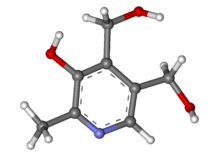ATC code A11HA02
 |
|

Pyridoxine
|
|
| Clinical data | |
|---|---|
| AHFS/Drugs.com | Monograph |
| Pregnancy category |
|
| Routes of administration |
by mouth, IV, IM, subQ |
| ATC code | |
| Identifiers | |
|
|
| Synonyms | vitamin B6, pyridoxol |
| CAS Number | |
| DrugBank | |
| ChemSpider | |
| UNII | |
| KEGG | |
| ChEBI | |
| ChEMBL | |
| ECHA InfoCard | 100.000.548 |
| Chemical and physical data | |
| Formula | C8H11NO3 |
| Molar mass | 169.18 g·mol−1 |
| 3D model (Jmol) | |
| Melting point | 159 to 162 °C (318 to 324 °F) |
|
|
|
|
Pyridoxine, also known as vitamin B6 and pyridoxol, is a form of vitamin B6 found commonly in food and used as dietary supplement. As a supplement it is used to treat and prevent pyridoxine deficiency, sideroblastic anaemia, pyridoxine-dependent epilepsy, certain metabolic disorders, problems from isoniazid, and mushroom poisoning. It is used by mouth or by injection.
It is usually well tolerated. Occasionally side effects include headache, numbness, and sleepiness. Normal doses are safe during pregnancy and breastfeeding. Pyridoxine is in the vitamin B family of vitamins. It is required by the body to make amino acids, carbohydrates, and lipids. Sources in the diet include fruit, vegetables, and grain.
Pyridoxine was discovered in 1934, isolated in 1938, and first made in 1939. It is on the World Health Organization's List of Essential Medicines, the most effective and safe medicines needed in a health system. Pyridoxine is available as a generic medication and over the counter. The wholesale cost in the developing world is about 0.59 to 3.54 USD per month. Foods, such as breakfast cereal have pyridoxine added in some countries.
...
Wikipedia
